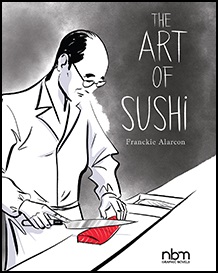112 and 160 pgs. full color | $39.99 | W & A: Franckie Alarcon
Food and comics are a natural combination—the visual aspects of cooking are well-suited to stylized illustration, while cultural context is easily conveyed through the combination of words and images. Plus, who isn’t interested in food? Only dead people is my guess.
French graphic artist Franckie Alarcon shows how it’s done in The Secrets of Chocolate: A Gourmand’s Trip Through a Top Chef’s Atelier and The Art of Sushi, translated by Montana Kane and Peter Russella, respectively, which are available at a discounted price as the “Great Food in Comics” set from NBM. Both are a pure delight to read, and the tutor in me can’t resist pointing out that you’ll learn something from them as well.
The Secrets of Chocolate takes the reader on a journey alongside the author, beginning with his childhood when he put chocolate powder on his bread and developed strong opinions regarding the best type of chocolate candy. As a young adult, Alarcon celebrated every birthday with chocolate-lemon cake, while as a working artist, his “daily stimulus” was “dark chocolate with 70% cocoa.” While working on a book about culinary careers, he met well-known chef Jacques Genin* for the first time and was blown away by his Saint Honoré (a type of pastry).
While working on this book, Alarcon visits Genin’s shop and kitchen, where he becomes a grown-up Willy Wonka surrounded by a cornucopia of chocolate-based treats. He also tries his hand at making a few recipes (not so easy as it looks!) and provides instructions for others. To round out his education, Alarcon visits the chocolatier Stephane Bonnat** where he (and we) learn how chocolate (not chocolate candy) is made, starting with the raw beans. Alarcon also takes a side trip to a chocolate plantation in Peru, and throughout these journeys he expresses such delight, both in chocolate and in everything he’s learning about it, that you can’t help but get caught up in his enthusiasm yourself.
The Art of Sushi takes a more sober tone but is equally enjoyable. Although sushi originated in Japan, today it’s enjoyed in many countries including France, whose citizens consume more of it than those of any other European country. Alarcon tries his hand making sushi in his home kitchen, but after a friend informs him that his maki should be square rather than round, he decides he needs to learn from the best—Tokyo’s Hachiro Mizutani.
Alarcon begins his quest with a lunch at Mizutani’s restaurant, where he and his friends get an education in how to make and consume sushi (e.g., it’s OK to eat it with your hands, but don’t drown it in the pickled ginger, which is meant as a palate cleanser). They then visit the Tzukiji fish market and get down and dirty in the details about selecting and preparing fish for sushi (this section is not for the faint of heart). As you might guess, there are layers upon layers of specificity involved in making sushi, from the types of swords used to cut different fish to how long to age the fish to maximize umami.
If Mizutani represents the venerable tradition of sushi, chef Okada is a spokesman for the new generation. He departs from tradition in some respects, including his choice of fish, with the goal of making sushi accessible to everyone, at a price they can afford and an atmosphere they enjoy. Since sake is often consumed with sushi, Alarcon and his friends also pay a visit to Hiroyuki Yoshikubo, president of Ippin Sake, and learn about the different types of sake and how they are made.
Alarcon’s graphic style is realistic but stylized, with lots of white space and targeted use of color. It’s an appropriate choice for these books: the colored elements pop out of the page, free of any interference from the black-and-white backgrounds, and the art is detailed but never feels crowded. His style is more exuberant in The Secrets of Chocolate, with greater use of color, no outlines around individual frames, and many pages designed as a single image. In The Art of Sushi Alarcon takes a more traditional approach, with many pages laid out in sequential bordered frames separated by gutters, and with more sparing use of color. Both styles work well, so it’s simply a case of the creator matching his art to the tone of each book. | Sarah Boslaugh
*Genin is explicit that he’s not a “chocolatier” but a “chocolate enrober” because he doesn’t make the chocolate from scratch, but is a craftsman who uses chocolate and other elements to make candy and pastries.
**Fun fact: Bonnat’s shop was an inspiration for Tim Burton’s Charlie and the Chocolate Factory.
The Secrets of Chocolate and The Art of Sushi are being released as the “Great Food in Comics” set by NBM, at the special price of $39.99 (regular price $45.00). You can preview the art for The Secrets of Chocolate here and The Art of Sushi here.


